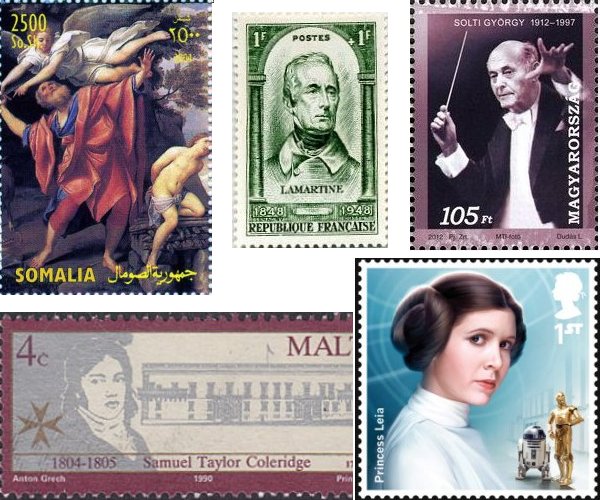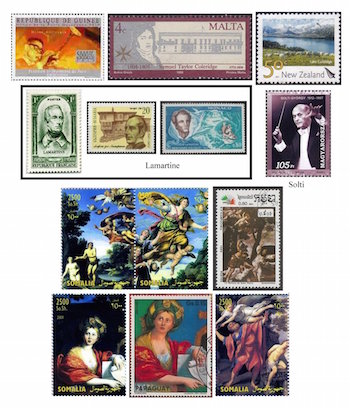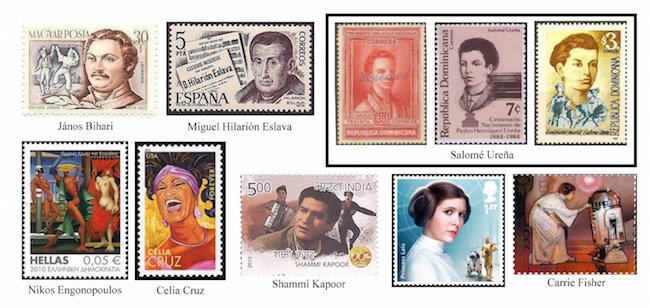The Arts on Stamps of the World —October 21
An Arts Fuse regular feature: the arts on stamps of the world.

By Doug Briscoe
Today is the one hundredth anniversary of the birth of Dizzy Gillespie. For October 21 we also salute Samuel Taylor Coleridge, Alphonse de Lamartine, and Georg Solti and we bid farewell to the late Carrie Fisher.
It’s really too bad that the only philatelic image I could find for John Birks “Dizzy” Gillespie (October 21, 1917 – January 6, 1993) for his centenary is a low-res scan of a stamp from a Guinean jazz set. A nice new one for the occasion would have been welcome.
The first of our two great poets is the Englishman Samuel Taylor Coleridge (21 October 1772 – 25 July 1834) from Devon. His vicar/headmaster father died when Coleridge was 8, and he went to a charity school where he met Charles Lamb and began writing poetry. At Jesus College, Cambridge he met another writer, poet Robert Southey. He and Southey married sisters in 1795, and in that year Coleridge met the third and most important literary figure in his life, Wordsworth. Before long, Coleridge had written both of his two most important creations, Kubla Khan and The Rime of the Ancient Mariner. On a trip to Germany with Wordsworth, Coleridge developed an interest in philosophy, to which study he would make his own contributions. He also translated Schiller’s Wallenstein trilogy into English. In 1804, he was in Sicily and Malta, on the latter island in an official capacity. So it is that our sole Coleridge stamp was issued by that nation. It was around this time that he began to lose himself in his opium addiction. Coleridge contributed significantly to Shakespearean scholarship with his lectures, particularly reversing the previously rather dismissive attitude toward Hamlet (lecture of 2 January 1812). From 1816, he lived in a London house owned by the physician James Gillman, and there he would live for the rest of his life, completing his most important work in prose, the Biographia Literaria, consisting of essays and notes on literary criticism and theory, as well as autobiographical notes. Since we have only the one Maltese Coleridge stamp, I thought I’d dress up our presentation with a New Zealand issue for Lake Coleridge, named in 1849 for two nephews of the poet.
The other great poet was the Frenchman Alphonse de Lamartine (21 October 1790 – 28 February 1869), who came to sudden prominence at age 30 with his masterpiece Les Méditations Poétiques (1820). Within five years he was named a Chevalier of the Legion of Honour and four years later a member of the Académie française. His poetry of was set by many of the most prominent French composers: Berlioz, Bizet (whose birthday is coming up Wednesday), Gounod, Saint-Saëns, Lalo, Satie, and Debussy. Lamartine’s words also served as the inspiration for two important instrumental compositions by Franz Liszt (whose birthday is tomorrow!): the overexposed but (IMHO) undeniably great Symphonic Poem #3, “Les préludes”, and the expansive piano collection “Harmonies poétiques et religieuses”, named for Lamartine’s eponymous volume of poetry (1830). Apart from his literary work Lamartine was very prominent in the political and diplomatic realms. At the French embassy in Italy from 1825 to 1828, Minister of Foreign Affairs for a short time in 1848, a candidate for the presidency in the same year, he was a central figure in the founding of the Second Republic. After a poor showing in the election, he gave up politics and focused on literature, but enjoyed no further great successes in that field, either, and died in poverty.
Sir Georg Solti was born György Stern in 1912 in Budapest to Jewish parents. Solti’s father renamed his children in accordance with a tendency common at the time for Hungarians with German names to adopt Hungarian ones. (Wikipedia: “The right wing regime of Admiral Horthy enacted a series of ‘Hungarianisation’ laws, including a requirement that state employees with foreign-sounding names must change them. Mor Stern, a self-employed merchant, felt no need to change his surname, but thought it prudent to change that of his children.”) Young György studied with Béla Bartók, Leó Weiner, and Ernő Dohnányi. Solti was given his first chance to conduct in public on the night of the Anschluss. Horthy’s government, in order to ingratiate itself with the Nazis, enacted anti-semitic laws, and Solti left Hungary for Britain, where he conducted the London Philharmonic for a season. It was around this time that Solti began to refer to himself as “Georg”. He lived in Switzerland throughout the war, after which he became music director of the Bavarian State Opera. He took West German citizenship in 1953, but returned to London and became a British citizen in 1972, although in the meantime (1969) he had been appointed music director of the Chicago Symphony. There he remained for 22 years, making some 250 recordings, including 45 complete operas. His groundbreaking recording of Wagner’s Ring is widely held to be one of the most important recordings ever made. Georg Solti won more Grammy Awards (32) than anyone, pop stars included. He died on September 5, 1997.

Italian painter Domenico Zampieri (October 21, 1581 – April 6, 1641) was saddled with the nickname Domenichino on account of his short stature. Born in Bologna, he moved to Rome in 1602 and entered the workshop of Annibale Carracci (whose birthday is in two weeks, Nov. 3). For a time he shared living quarters with Guido Reni (whose birthday is the next day, Nov. 4!). After Carracci’s death in 1609, four of his students, Domenichino among them, were elevated to the position of Rome’s leading painters. In 1614 he painted his first and finest altarpiece, The Last Communion of St. Jerome for the church of San Girolamo della Carità. Apart from a period in four years back in Bologna and at Fano, Domenichino remained in Rome until accepting an important commission for the Naples Cathedral in 1631. Our stamps include singles from Paraguay and Cambodia and a sheet from Somalia, which I’ve divided into segments. In the first pair are God admonishing Adam and Eve (1633, “Hey, it’s not my fault—look, she made me do it.”) and The Assumption of Mary Magdalene (1620). The stamp from Cambodia shows The Martyrdom of St. Peter (c1618-20 or c1626). The Cumaean Sibyl (1616-17) appears on the third Somalian stamp and in a redrawing on the Paraguayan one, and the final stamp offers (unhappy choice of verb?) The Sacrifice of Isaac (1627-28). I provide links to three more lovely pieces: Diana and her Nymphs (1616-17), St John the Evangelist (1624-29), and a musical number, St. Cecilia playing the Viol (1617-18).
János Bihari (YAH-nosh BEE-hah-ree, October 21, 1764 – April 26, 1827) was a seminal figure in Romani academic music and is credited with the invention of the verbunkos (VAIR-boon-kosh, a dance form used by Bartók and others). He was an influential Hungarian Romani violinist until he injured his hand in 1824. He composed some 84 pieces, some of the melodies being used by such composers as Liszt, Beethoven, and Sarasate. Unable to maintain his career as a violinist, he died in poverty in Pest.
Spanish composer Miguel Hilarión Eslava y Elizondo (21 October 1807–23 July 1878) was a remarkably important figure. Why had I never heard of him? In 1828 he was named maestro de capilla at the cathedral in El Burgo de Osma and just months later applied for the same position at the Seville Cathedral, which he took in 1832. 1844 saw him ensconced at the Chapel Royal in Madrid, and ten years after that he was appointed professor of composition at the capital’s conservatory. He made extensive studies of the many musical manuscripts to which he had access, and his efforts resulted in the creation of the Lira Sacro-Hispana, a compendium published in seven (or ten?) volumes between 1852 and 1860. In addition, he was a co-founder of La España Musical, a society devoted to the preservation of Spanish opera and zarzuela. As a composer he wrote 140 sacred motets, 10 masses, organ works, and three operas, which, perhaps surprisingly, follow the Italian model. There is also an intriguingly titled Sinfonía fantástica (Berlioz at the Pearly Gates?). But the only recording of his music I can find is on a French anthology album of Spanish organ works.
Greatly revered in her native Dominican Republic, Salomé Ureña de Henríquez (October 21, 1850 – March 6, 1897) was a lyric poet and an innovator in women’s education. Born in Santo Domingo, she was the daughter of the writer Nicolás Ureña de Mendoza. She followed in his footsteps by issuing her first poetical works when she was 17. Her marriage at 30 to a politically active doctor produced four children, including the future literary critic Pedro Henríquez Ureña. It was around this time (c1881) that she and her husband opened the Instituto de Señoritas, the first school of higher education for women in the Dominican Republic. Ureña died from complications of tuberculosis at 46.
Greek artist Nikos Engonopoulos (October 21, 1907 – October 31, 1985) excelled at both painting and poetry. Athens born, he found himself, aged 7, stranded with his family in Constantinople on the outbreak of World War I. At 16 he enrolled in a lycée in Paris. After military service and working a few select clerical positions he attended the Athens School of Fine Arts, where one of his professors was Konstantinos Parthenis. His first exhibition in 1938 was very soon followed by his translations of poems by Tristan Tzara, the publication of his first collections of original poems, and his first solo exhibition, all of this in 1938-39. Engonopoulos is viewed as one of the finest surrealist poets of Greece, yet his stamp presents a painting, an entirely characteristic one called Orpheus, Hermes, and Euridice, which clearly demonstrates his devotion to surrealism in the visual arts as well. He made many similar representations of characters from Greek mythology and history, such as Orpheus.

It’s also the birthday of Cuban singer Celia Cruz (October 21, 1925 – July 16, 2003), said to be the most popular Latin artist of the 20th century, with twenty-three gold albums. Known variously as “Queen of Salsa”, “La Guarachera de Cuba“, and “The Queen of Latin Music”, Cruz, while still very young, explored santería songs and the words to Yoruba songs, continuing on to study theory, voice, and piano at National Conservatory of Music in Havana. After a start in radio, she made her first recordings in Venezuela in 1948. She was taken on as a singer with the band Conjunto Sonora Matancera in 1950 and remained with them for fifteen years, even though her name was soon a bigger draw than that of the band. She appeared as herself in cameos in some Mexican films, but when Castro took over she and her husband were not allowed to return to Cuba, and they became US citizens in 1961. Cruz had a productive association with Tito Puente from 1966. She was a Grammy Award winner in 1990 (Best Tropical Latin Performance). Two years later she starred opposite Armand Assante and Antonio Banderas in the movie The Mambo Kings. Celia Cruz succumbed to brain cancer at age 77.
Shammi Kapoor (21 October 1931 – 14 August 2011) was a major star in Hindi cinema beginning in the late 1950s, known especially for his romantic comedies. He came of a show biz family in Mumbai, his father and brothers all actors. Kapoor also directed a couple of pictures in the 70s.
The late lamented Carrie Fisher (October 21, 1956 – December 27, 2016) also diversified from her acting, but in her case as a busy writer. Known in the latter capacity for her autobiographical Postcards from the Edge and Wishful Drinking, she also worked for fifteen years or more as a much consulted Hollywood script doctor. The daughter of stars Eddie Fisher and Debbie Reynolds, and the step-daughter of Connie Stevens, she was known as a bookworm as a child, trying her hand at poetry. Her first film role was in Shampoo (1975), and only two years later, at age 20, she took the part of Princess Leia in Star Wars. It was at that time that she met and fell in love with Paul Simon, whom she later married for a little while. She was also romantically involved with Dan Aykroyd, whom she met while working on The Blues Brothers. You will recall (who could forget?) that she predeceased her mother Debbie Reynolds by a single day. Fisher’s last film, Star Wars: The Last Jedi, is set for release on December 15.
A happy birthday to the fine American writer of science fiction Ursula K. Le Guin (born October 21, 1929). She turns 88 today.
A graduate of the University of Massachusetts with a B.A. in English, Doug Briscoe worked in Boston classical music radio, at WCRB, WGBH, and WBUR, for about 25 years, beginning in 1977. He has the curious distinction of having succeeded Robert J. Lurtsema twice, first as host of WGBH’s weekday morning classical music program in 1993, then as host of the weekend program when Robert J.’s health failed in 2000. Doug also wrote liner notes for several of the late Gunther Schuller’s GM Recordings releases as well as program notes for the Boston Classical Orchestra. For the past few years he’s been posting a Facebook “blog” of classical music on stamps of the world, which has now been expanded to encompass all the arts for The Arts Fuse.
